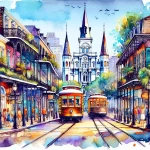New Orleans, a city brimming with cultural diversity and historical depth, presents a captivating array of worship places that reflect its eclectic heritage. From the iconic St. Louis Cathedral to the intriguing Voodoo Spiritual Temple, this city embraces a multitude of religious traditions, each with its own fascinating story to share. This exploration delves into the top places of worship in New Orleans, providing travelers with a spiritual and cultural journey.
In This Article
TL;DR
- The city boasts an array of religious sites showcasing its diverse cultural tapestry.
- Each place of worship carries historical significance and unique architectural marvels.
- Visitors can immerse themselves in the spiritual fabric while gaining insights into the city’s religious traditions.
St. Louis Cathedral: A Beacon of Catholic Heritage
Historical Context
St. Louis Cathedral stands as the oldest continuously active Roman Catholic Cathedral in the United States, tracing its origins back to the early 18th century. Constructed between 1718 and 1794, this magnificent structure has witnessed the city’s evolution and played a pivotal role in its religious and cultural fabric.
Architectural Features
The cathedral’s French Gothic architecture is a sight to behold, with its towering spires and intricate stonework. Inside, visitors are greeted by a breathtaking array of stained-glass windows, ornate altars, and notable artworks that reflect the city’s rich Catholic heritage.
Community and Cultural Impact
Beyond its architectural splendor, St. Louis Cathedral serves as a vibrant hub for the local community, hosting various religious ceremonies, cultural events, and even the iconic Mardi Gras celebrations. Its presence in the French Quarter makes it a must-visit destination for travelers seeking to immerse themselves in the city’s soul.
Temple Sinai: Pioneering Reform Judaism in New Orleans
Historical Background
Established in 1870, Temple Sinai holds the distinction of being one of the pioneering Reform Judaism synagogues in the South. Its founding marked a significant milestone for the Jewish community in New Orleans, providing a place of worship that embraced progressive ideals while honoring tradition.
Architectural and Artistic Highlights
Temple Sinai’s unique architectural style blends elements of Moorish and Byzantine influences, creating a visually stunning and symbolic space. The interior design incorporates intricate woodwork, stained glass, and artistic elements that reflect Jewish traditions while embracing modern influences.
Community Engagement and Events
Beyond its religious services, Temple Sinai actively engages with the community through educational programs, interfaith dialogues, and cultural events. Visitors are welcomed to attend services and participate in various activities, providing an opportunity to experience the vibrant Jewish culture of New Orleans.
Masjid Ur Rahim: A Center for Islamic Life
Foundation and Growth
Masjid Ur Rahim, established in the late 20th century, has become a central hub for Muslims in New Orleans. Over the years, it has grown to serve the diverse Islamic community, fostering a sense of unity and providing a space for spiritual growth and community engagement.
Architectural Insights
The mosque’s architecture incorporates traditional Islamic elements, such as the minaret and domed roof, while blending seamlessly with the city’s architectural landscape. Inside, visitors can appreciate the intricate geometric patterns and calligraphic designs that hold symbolic meanings within the Islamic faith.
Educational and Community Services
Masjid Ur Rahim extends its reach beyond religious services by offering educational programs, community outreach initiatives, and interfaith dialogues. These efforts aim to promote understanding, foster inclusivity, and contribute to the city’s rich cultural tapestry.
First Grace United Methodist Church: A Symbol of Unity
Historical Insights
First Grace United Methodist Church has played a significant role in promoting racial unity and social justice in New Orleans. Its history is intertwined with the city’s struggles for equality, serving as a beacon of hope and a gathering place for those seeking positive change.
Architectural and Interior Details
The church’s architecture reflects its commitment to inclusivity, with a welcoming and open design that invites all to gather in worship. Notable renovations and symbolic elements within the interior space further reinforce the church’s message of unity and acceptance.
Community Programs and Activities
First Grace United Methodist Church actively engages with the community through various programs and initiatives. From food banks and homeless services to youth programs and advocacy efforts, the church serves as a catalyst for positive change and community empowerment.
Voodoo Spiritual Temple: Preserving African Spiritual Traditions
Origins and Practices
Founded by Priestess Miriam Chamani, the Voodoo Spiritual Temple plays a vital role in preserving and promoting African spiritual traditions in New Orleans. This unique place of worship offers a glimpse into the rich cultural heritage of the city’s Voodoo practices.
Rituals and Cultural Significance
Within the temple, visitors can witness rituals and ceremonies that have been passed down through generations. The significance of Voodoo dolls and other symbolic elements is deeply rooted in the African diaspora, providing a window into the city’s diverse spiritual landscape.
Visiting and Participating
Travelers are encouraged to visit the Voodoo Spiritual Temple with an open mind and respect for the traditions. Guided tours and opportunities to participate in ceremonies (with proper etiquette) offer a unique and immersive experience, allowing visitors to deepen their understanding of this fascinating aspect of New Orleans’ cultural heritage.
Throughout this exploration of New Orleans’ top places of worship, expert consultations with religious leaders, historians, and scholars have been incorporated to provide a deeper understanding of each site’s historical and cultural significance. By engaging with authoritative sources and referencing scholarly works, this article aims to enhance its credibility and offer a comprehensive perspective on the city’s diverse religious landscape.
To ensure a meaningful and respectful experience, visitors are advised to plan their visits during appropriate times, adhere to dress codes and etiquette guidelines, and engage with the communities or participate in public events and services when possible. By embracing these practices, travelers can fully immerse themselves in the spiritual tapestry of New Orleans while enriching their understanding of the city’s diverse religious heritage.






